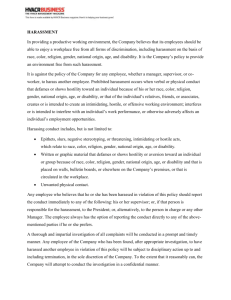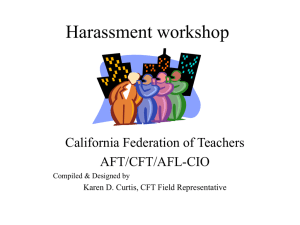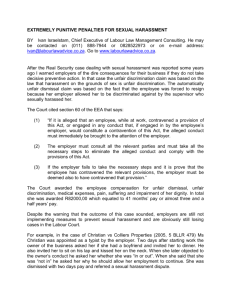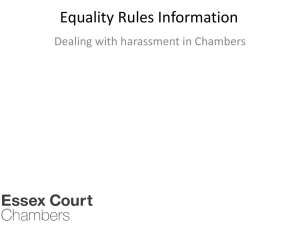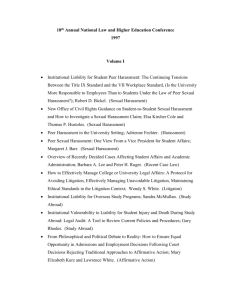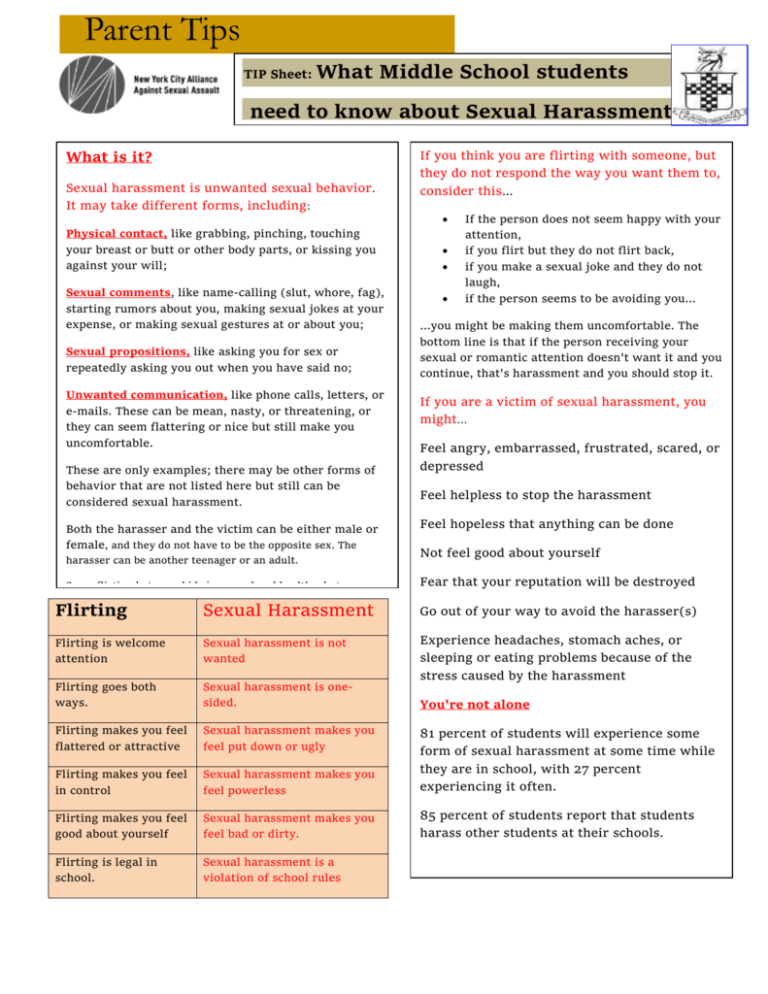
Parent Tips
TIP Sheet:
What Middle School students
need to know about Sexual Harassment
What is it?
Sexual harassment is unwanted sexual behavior.
It may take different forms, including:
Physical contact, like grabbing, pinching, touching
your breast or butt or other body parts, or kissing you
against your will;
Sexual comments, like name-calling (slut, whore, fag),
starting rumors about you, making sexual jokes at your
expense, or making sexual gestures at or about you;
Sexual propositions, like asking you for sex or
repeatedly asking you out when you have said no;
Unwanted communication, like phone calls, letters, or
e-mails. These can be mean, nasty, or threatening, or
they can seem flattering or nice but still make you
uncomfortable.
These are only examples; there may be other forms of
behavior that are not listed here but still can be
considered sexual harassment.
Both the harasser and the victim can be either male or
female, and they do not have to be the opposite sex. The
harasser can be another teenager or an adult.
Some flirting between kids is normal and healthy, but
sometimes it can be hard to tell the difference between flirting
and sexual harassment. The lists below can help you figure it
out.1 (NOTE: An adult flirting with a kid is not normal or ok.)
If you think you are flirting with someone, but
they do not respond the way you want them to,
consider this...
If the person does not seem happy with your
attention,
if you flirt but they do not flirt back,
if you make a sexual joke and they do not
laugh,
if the person seems to be avoiding you...
...you might be making them uncomfortable. The
bottom line is that if the person receiving your
sexual or romantic attention doesn't want it and you
continue, that's harassment and you should stop it.
If you are a victim of sexual harassment, you
might...
Feel angry, embarrassed, frustrated, scared, or
depressed
Feel helpless to stop the harassment
Feel hopeless that anything can be done
Not feel good about yourself
Fear that your reputation will be destroyed
Flirting
Sexual Harassment
Go out of your way to avoid the harasser(s)
Flirting is welcome
attention
Sexual harassment is not
wanted
Flirting goes both
ways.
Sexual harassment is onesided.
Experience headaches, stomach aches, or
sleeping or eating problems because of the
stress caused by the harassment
Flirting makes you feel
flattered or attractive
Sexual harassment makes you
feel put down or ugly
Flirting makes you feel
in control
Sexual harassment makes you
feel powerless
81 percent of students will experience some
form of sexual harassment at some time while
they are in school, with 27 percent
experiencing it often.
Flirting makes you feel
good about yourself
Sexual harassment makes you
feel bad or dirty.
85 percent of students report that students
harass other students at their schools.
Flirting is legal in
school.
Sexual harassment is a
violation of school rules
You're not alone
Page 3
Get help
Help someone else
Because "sexual harassment" is a term that can describe many
different behaviors, the kind of help available to you may differ,
depending on exactly what the person harassing you has done. In
many cases, the harassment will probably not constitute a crime, but
rather a violation of school rules (especially if there is no touching
involved and no threats have been made). This means that it will be
handled through school administration rather than the criminal
justice system (police, court, etc.) In such a case, you can begin by
following the steps outlined below.
If you see harassment happening in
your school, you can help put a stop to
it.
Tell the person harassing you that their behavior makes you
uncomfortable and you want them to stop. You can do this face-toface or in writing. If you write them a letter, save a copy of it for
yourself. In some cases, this will be enough to stop the behavior. (If
you don't feel comfortable doing this by yourself, you can ask a friend
or an adult for help. Or just skip this step and begin with the next
one.)
Refuse to join in.
If you feel safe doing so, step in
and interrupt the harassment.
Tell an adult you trust. Don't be
a bystander.
Talk to the person being
harassed and try to get them to
talk to an adult. Offer to go with
them.
If the person doesn't stop when you ask them to, get a copy of your
school's sexual harassment policy. By law, the school has to have one.
The policy will tell you who to report to and how to do it. It can also
help you understand what behaviors are considered harassment.
Report the harassment to the appropriate person in your school,
and/or tell a parent.
If the harassment doesn't stop, keep a journal documenting each
incident. Write down what happened, when and where it happened,
whether there were any witnesses (and their names if you know
them), how it made you feel, and how you responded. Then take this
documentation to school administrators and ask them to take action
to stop the harassment.
Be persistent. If the first person you tell doesn't take you seriously,
keep telling someone in authority until something is done about it.
The school's policy should indicate the "chain of command" your
complaint should go through. (For example, if the person the school
has assigned to handle sexual harassment complaints doesn't take
action, you may need to go to the principal, and if the principal also
does not respond, you might next go to the superintendent. See your
school's policy for details.)
If the school administration does not stop the harassment, you may
wish to consult an attorney. If you don't know who to call, you can
contact the Bermuda Police Service
Certain behaviors that are sometimes part of a pattern of sexual
harassment are, in fact, crimes. These can include threats, assault
(such as a push, shove, punch, or kick), stalking (when a person's
pattern of behavior makes you fear for your safety), sexual assault
(when someone forces you into a sexual act), and property crime
(when someone takes, vandalizes, or destroys a possession of yours).
Provided by the Whitney Institute
Middle: School Guidance Department
September 2015



